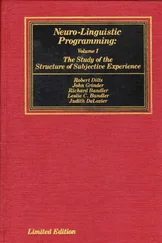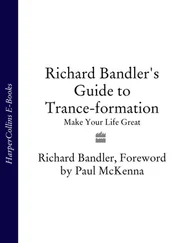The first self–induction method I want to describe is Betty Erickson's technique. Betty is Milton's wife, and she is extremely sophisticated in putting herself into various altered states. She can jump in and out of many different states very quickly. The technique that she developed presupposes representational systems, Erickson, by the way, is the only person other than us who had an explicit understanding of representational systems; he knew that there are three major ones, and that there are predicates which identify them.
Betty uses representational systems in this induction. She seats herself in a comfortable place and finds something that's easy to look at. I would probably choose some place where the light is reflecting, such as some of the cut glass that is hanging from that chandelier. I fix my gaze on that, and then I say three sentences to myself about my visual experience. "I see the light glittering on the various pieces of cut glass; I sec the movement of somebody's bare arm; I see that somebody just looked up at the chandelier."
Now I switch to auditory, and make three statements about that portion of my experience. "I hear the sound of the ventilation system; I hear the sound of paper being rustled as people are making notes; I hear the sound of somebody clearing her throat."
Then I make three statements about my kinesthetic experience. "I can feel where the soles of my feet are making solid contact with the platform I'm standing on; I can feel the weight of my jacket as it lies across my shoulders; I can feel the warmth where my fingers are interlaced as I stand here." I've made three statements about my ongoing visual experience, three about my auditory, and three about my kinesthetic.
Then, maintaining the same position and the same direction of gaze, I recycle through each sensory channel, making two statements for each. I pick out two additional visual, auditory, and kinesthetic parts of my experience. Then I recycle through the three channels again, picking out one of each. Typically, even for beginners, about the time you get half way through the cycle of two sentences for each system, your eyes start to get drowsy, and you get tunnel vision. If your eyes get drowsy, you just allow them to close and substitute internal visualization for external. You can still use external experience for auditory and kinesthetic statements.
Man: Do you say the statements out loud when you are doing it for yourself?
it doesn't matter. Use whichever is easiest for you. Many of you will find that after you've done this half a dozen or so times, all you have to do is say "Well, 1 think I'll do that induction" and you're there! All I have to do is look over there at the cut glass and I get tunnel vision, which is one of the indicators that I'm going into an appropriate trance.
Woman: Do you have to do it in that sequence: visual, auditory, then kinesthetic?
No. If you happen to know your own preferred sequence, use that to pace yourself. If you tend to go visual, kinesthetic, and then auditory, then use that sequence. That will make it more powerful for you, but it will also work the other way.
Woman: You don't use the same sentences each time you cycle through, do you?
Use different ones each time, consistent with whatever your experience is at the moment. Notice that you are setting up a biofeedback loop. That is, you are representing in words exactly the experiences you are having visually, auditorily, and kinesthetically. One of the essential characteristics of all good hypnotic or altered states work is that particular loop. This is very similar to the 5–4–3–2–1 exercise that we discussed earlier, and it is the first phase of the Betty Erickson technique.
In the next phase I first sense which hand and arm feels lighter. Then I give suggestions to myself by saying that the hand that feels lighter will continue to feel lighter, and will begin to float up with honest unconscious movements, feeling attracted toward my face, so that when it makes contact with my face, I will sink into a deep trance.
The second self–hypnosis method is similar to the first, but you use internal representation instead of external representation. You sit or lie down in a comfortable place and make an internal visual image of what you would look like if you were standing five feet in front of yourself, looking at yourself. If you have any trouble constructing such an image, you already know a pattern which will assist you in doing that—overlap. Begin with the kinesthetic sensation of your breathing, or the sound of your breathing, and overlap to seeing your chest rising and falling. Continue to develop and stabilize that image of yourself until you can see it in greater detail. Eventually you will be able to see the rise and fall of your chest, which will be correlated with the kinesthetic sensations of your chest rising and falling as you breathe.
Continuing to see that image of yourself, you then shift your awareness to the very top of your head and kinesthetically sense temperature, tension, moisture, pressure, etc. — any distinction you are able to make kinesthetically. You work your way slowly down through your body, sensing each part of your body. As you look at that visual image of yourself from the outside, you're sensing what's going on in your body kinesthetically.
Next you add on auditory representation. As you see the image and sense your body kinesthetically, you describe your experience to yourself internally. "I feel a tension in my right eyebrow, and as I sense it, it begins to go away." All three systems are representing the same information. You are seeing, feeling, and hearing what your actual experience is at that moment.
After you've gone all the way through your body in this way, then you can add the same piece on at the end that I gave you for the other method. As you sense which hand and arm feels lighter, you see that hand and arm in the image beginning to lift up, feeling attracted toward your face. Then you describe it auditorily "My left hand is beginning to lift with honest, unconscious movements." Even if you don't know what honest, unconscious movements are, your unconscious does. Leave that to her. "My hand will continue to feel lighter and be attracted to my face. When it touches my face, I'llsink into a nice deep trance." You can say these things to yourself either sub–vocally or out loud if that is more convenient. If you say this out loud, shut the door, or people will think you are very weird.
Man: I have found it easier to get my hand up if I see a long handle pulling it up.
Or you can use a helium balloon. There are lots of extra things you can add to this. Use whatever else you can incorporate into your images and feelings and words that will help you accomplish each step. I'm giving you the basics. There are lots of nice artistic ways of doing it.
Man: If I'm using the internal image of myself out there and I feel my left hand lighter than my right, do I see that as a mirror image or the other way?
Try it both ways and find out which,is more effective for you.
Man: What's the purpose of having your hand touch your face?
The exact task that you pick to do is arbitrary. Most people report that their hand and arm did lift, and when it touched their face they felt a sudden, radical change, and that they had amnesia after that point.
Before you begin either one of these exercises, and any time in the future when you decide to do self–hypnosis or meditation, give your unconscious an instruction about how long to keep you there and when to arouse you. You might say to yourself before you begin either one of these exercises "I would like you, my unconscious, to arouse me in fifteen minutes, allowing me to feel refreshed and renewed by this experience." Your body is an exquisite time clock. If you measure the time it takes a person to come back out of trance, it's usually within a quarter minute of the time they had specified. The worst that would ever happen, even if you forgot that instruction, is that you might go into a nice deep physiological sleep and wake refreshed several hours later.
Читать дальше











